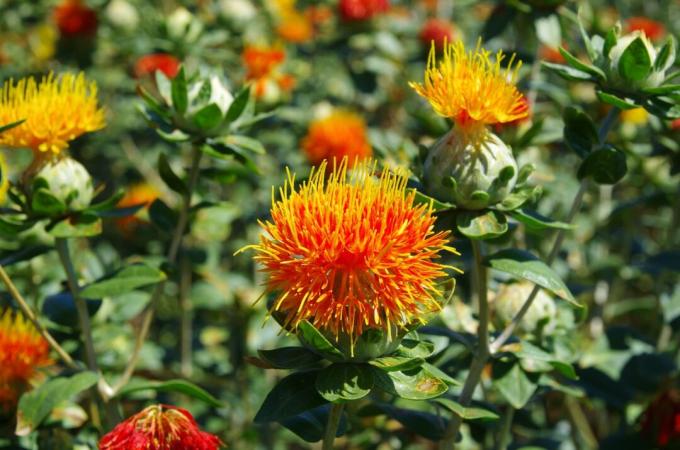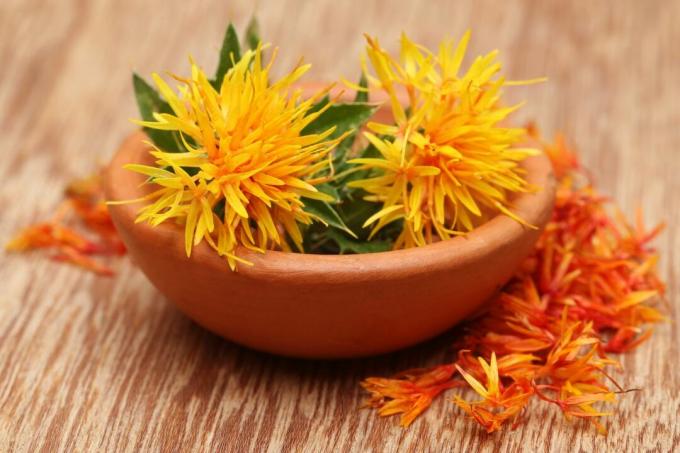With its bright flowers, the safflower is not only an eye-catcher in the garden, but is also used in a wide variety of applications.

The growth of the safflower resembles (Carthamus tinctorius), as the name suggests, a thistle. Its idiosyncratic ornamental value and frugality in care make false saffron an interesting garden plant. You can find out more about the properties, sowing and use of the safflower here.
contents
- Safflower: origin and properties
- Sowing the safflower
- The right care
- Use of the safflower
- What is the effect of safflower?
Safflower: origin and properties
The safflower is also known by other names such as safflower, oil safflower, safflower and false saffron. No clear statement can be made about the origin of the oil thistle, as it is already widespread worldwide. It is thought to have come from Asia Minor. In addition, the plant is probably a cultural hybrid, originating from the species in ancient times
Carthamus persicus and Carthamus palestinus has arisen. Already 3500 BC Chr. the safflower was used for dyeing in Egypt.Although the safflower is an annual plant, it overwinters in the tropics and subtropics. In Central Europe, on the other hand, the specimens that germinated in autumn usually do not make it through the winter. Only the spring seedlings will flower in the same year. The herbaceous plant belongs to the daisy family (Asteraceae) and has a deep taproot. The weakly branched main shoot grows out of a leaf rosette and is about 60 to 130 cm high. The elongated leaves of the safflower are bright green and have spiked edges. Depending on the type and variety, the spike tips are more or less pronounced.

At the end of each shoot is a cup-shaped flower containing 20 to 150 yellow-orange tubular flowers. The balloon-like, thick shape of the flower heads is characteristic. The heyday of Carthamus tinctorius extends from June to August, providing bees, bumblebees and other insects with nutritious nectar and pollen. The safflower is very bee-friendly and has good nectar and pollen values.
Sowing the safflower
Seeds of the safflower can be purchased from seed suppliers on the Internet or in garden shops. After the safflower has been cultivated for the first time, it can be propagated further with the self-harvested seed. This can be taken from the inflorescences in September and October.
The fast-growing summer flower can easily be sown directly outdoors from mid-April to early June. A preculture on the windowsill from March is not necessary. The safflower could even be sown in autumn, as the seeds can withstand temperatures down to -10 °C and then simply germinate the next year. Since the safflower forms a taproot, pot culture is less suitable. If it is nevertheless desired, a deep bucket should be used, which is filled with potting soil and 30 to 40% drainage material.
For outdoor sowing, it is best to choose open, loosened soil in a warm and sunny location. This favors the germination process and the development of the plants. The seeds are placed 20 - 30 cm apart about 2 - 3 cm deep in the soil, which is ideally well drained and loamy-sandy. If the soil is too clayey, it should be thinned with plenty of sand. In the youth phase, it makes sense to pay attention to a regular water supply. After about two to three weeks of germination, the first little plants will appear.

Good plant neighbors: The safflower is ideal for rural or rural gardens as a component in alternating pile borders or temporarily in perennial borders. Well suited plant partners are, for example, the Nodding Thistle (Carduuns nutans), the common chicory (Cichorium intybus), the cotton thistle (Onopordum acanthium) and the common viper's tongue (Echium vulgare).
The right care
Once the oil safflower has grown properly, hardly any further care measures are necessary. Due to its deep-reaching taproot, it can usually provide itself with sufficient water and nutrients. A permanently fresh water supply is good, especially in spring, but the plants do not care about drought in summer.
A long-term fertilizer can be mixed into the soil before sowing to ensure the daisy plant is optimally supplied with nutrients. Ours, for example, is well suited for this Plantura organic universal fertilizer, because with its coordinated nutrient composition it ensures vital, lush green foliage, healthy plant growth and numerous blossoms. In addition, it consists of 100% natural raw materials and valuable minerals and contains no animal waste products.
Is the safflower hardy? The safflower can withstand temperatures down to around – 7 °C. But since it is only an annual anyway, dies towards the end of the year and has to be sown again the next year, this is less important.

Use of the safflower
To a greater extent will Carthamus tinctorius grown to make safflower oil from the seeds. This contains a very high proportion of unsaturated linoleic acid and vitamin E and is used in the kitchen as cooking oil, but also for the production of paints and varnishes.
As the name suggests, the plant also dyes textiles. To do this, the intensely colored petals of the safflower are first washed out, then dried and finally the typical safflower red is obtained in an alkaline solution.
The safflower is also used as a medicinal or medicinal plant. For example, the dried petals are used for tea infusions.
The plant is also known under the name false saffron for a reason, because its petals are used as a spice substitute for the expensive saffron. Here, however, the color is mainly imitated, because the taste is extremely mild.
Finally, the safflower is used in floristry as a dried or cut flower. The thornless varieties are particularly in demand.

What is the effect of safflower?
Due to its high proportion of unsaturated fatty acids, safflower oil is said to have extremely positive effects on health. Not much research has been done in this area, but according to studies, the oil should, for example, lower high cholesterol levels or have positive effects on diabetes. The tea brewed from the petals of the safflower is said to reduce fever and relieve pain.
Another plant with a thistle-like growth and flowers with a high ornamental value is the globe thistle. It also attracts bees and bumblebees to the garden during flowering. You can find out more about the globe thistle and how to care for it in our special article.



